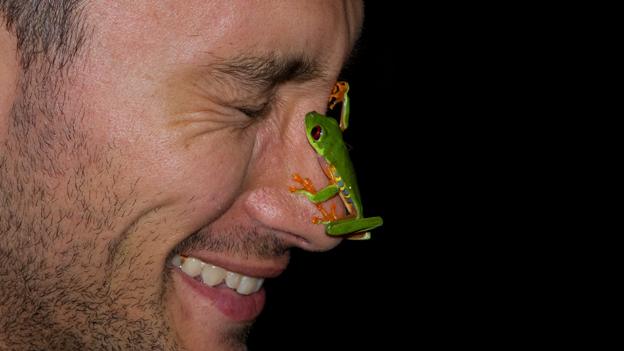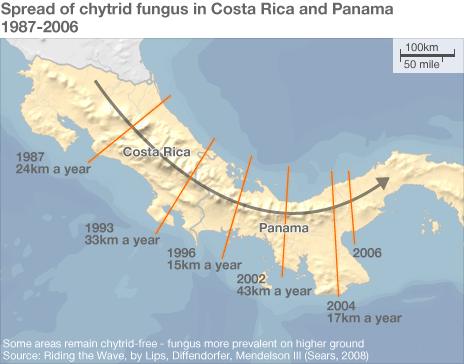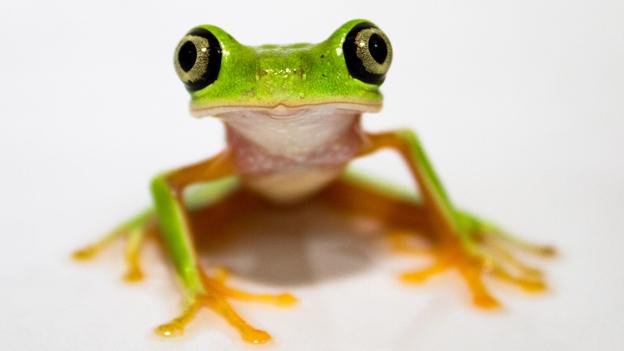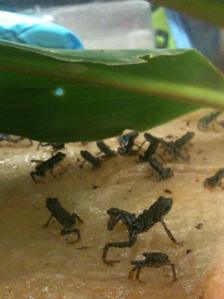The race to get rainforest frogs into arks
- Published

Frogs matter - they play a vital role in the food chain, and some have been found to produce chemicals that cure human diseases. But a fungus dubbed "the amphibian smallpox" is making many species extinct. So scientists are mounting a rescue operation.
It's the middle of the night in the rainforests of central Panama.
Biologist Brian Gratwicke slogs through a stream with a group of researchers looking for little green blobs sitting on leaves.
"Anything that makes the leaf hang unusually," he says.
A colleague spots a pair of tiny eyes gleaming in the beam of a torch. But it's a false alarm - probably just a spider, and spiders are not the team's quarry.
The little green blobs they are looking for are frogs, and after 90 minutes in the jungle, they have yet to find a single one.
It might just be bad luck, but probably not. Frogs around the world are in decline. In recent years, scientists have documented frog population decreases of up to 80% in some areas.
Habitat loss, climate change and pollution, are all playing a role in the disappearances.
Another culprit is "chytrid" - a virulent fungal disease, thought to have originated in Africa, that's spreading around the globe.
In parts of Central America the fungus is moving at around 20 miles (32km) a year.

That's why biologists in Panama, with some help from Gratwicke and his colleagues from the Smithsonian National Zoo in Washington DC, are out collecting frogs and other amphibians ahead of the arrival of the fungus.
Finally, the team is successful.
Gratwicke spots a "glass frog" guarding a gelatinous pile of eggs, with tiny tadpoles wiggling inside. "Right above its stomach you'll see a teeny white thing beating. That's its heart," he says.
It's a stunning sight, but that's it for this expedition, just a single frog.
The researchers have had better luck elsewhere. When they do find frogs, <link> <caption>they pack them into plastic bags</caption> <url href="http://www.theworld.org/2012/02/rescue-frogs-amphibian-arks/#video" platform="highweb"/> </link> and "medevac" them out of the forest like injured soldiers.

They take them to protected environments like the Summit Zoo in Gamboa, Panama.
At the zoo, several shipping containers have been converted into what the scientists call "pods", where disease-free frogs live in captivity.
"Some of these frogs are coming from cloudy mountain forests," says Angie Estrada, one of the researchers at the zoo, "so our pods need to have low temperatures and high humidity. They need lights that resemble night light and day light. We also need to use UV lights to allow them to go through metamorphosis."
The pods hold the very last of some frog species.
"We call them arks," Estrada says, "amphibian arks, because we're basically keeping these frogs alive for future generations."
It's a desperate effort, as the scientists race to keep ahead of the onward march of the disease.
"Once the fungus starts to kill the frogs, it kills them fast," says Edgardo Griffith, who runs another conservation project in western Panama, called El Valle. The fungus swept through that area several years ago.
"From the get-go we were behind the wave. When the fungus arrived here, we didn't have a facility to protect them. We had to keep frogs in hotel rooms."
Griffith's new facility is a little more sophisticated. He has a quarantined building that is now home to a dozen vulnerable local species.
But being as exotic as they are also means there's no rule book on how to take care of them. Nobody knew exactly what some of them ate, or what they needed to mate. The researchers are learning as they go along.

Lemur Leaf frog (critically endangered)
Brian Gratwicke from the Smithsonian National Zoo says there are compelling reasons for rescuing all of these frogs.
"There's a species in Australia that produces a chemical called caerin, which blocks HIV transmission to T-cells," he says. "The skin of another species has produced compounds that have been shown to kill 'superbugs' in hospitals. The untapped resources of our amphibian biodiversity are virtually unknown," he adds.
But there's another important reason for the frog rescue.
Gratwicke quotes a legendary American ecologist called Aldo Leopold: "'To keep every cog and wheel is the first rule of intelligent tinkering.'" In this case, he says, amphibians are more than just the cogs and wheels. They are the entire middle of the food chain. "They eat the bugs and are then eaten by snakes and birds and other things. So we want to make sure we look after them."
The species now being sheltered in Panama cannot return to the wild to continue their vital ecological role without some kind of solution to the fungus problem, as once the fungus arrives it stays.
That's why the latest research in the United States is being watched with great interest.

Atelopus certus babies born in captivity (endangered species)
While studying another amphibian, the salamander, a professor in Virginia noticed something curious.
"The females would squirm through their eggs periodically," says Reid Harris of James Madison University. "If they deserted the nest, fungus would take it over, and there would be no survival of the offspring."
He deduced that bacteria on the skin of the salamanders was acting as a protection against fungal attack.
There are now efforts to develop this research, by looking for bacteria that may protect frogs in the wild - though scientists warn there is no immediate prospect of a miracle cure that will allow them to survive in chytrid-infected areas.
At the Summit Zoo in Gamboa (Panama), researcher Angie Estrada has had a breakthrough in her efforts to save at least one endangered species.
In one of her frog pods, 80 miniature black and green frogs are hopping around. Estrada says they are a species called Atelopus certus. And there's been a new addition - "One of the first Atelopus born in captivity!" she exclaims.
The species is native to one sliver of the Panamanian rainforest. She says the fungus is expected to arrive there in a year or two, and that 90% of the species there will die as a result.
Estrada hopes that one day, if the hunt for a solution to the chytrid problem is successful, her new baby amphibians may be able to leave the ark and return to their parents' forest home.
"I know it's crazy," says Estrada, "but I'm hoping some of the individuals here are going to be the founders for re-populating these areas!"
Additional reporting by Rob Hugh-Jones.
<italic>Watch a </italic> <link> <caption>slideshow of frogs found in Panama</caption> <url href="http://www.theworld.org/2012/02/rescue-frogs-amphibian-arks/#slideshow" platform="highweb"/> </link> <italic>and listen to more on this story at </italic> <link> <caption>PRI's The World</caption> <url href="http://www.theworld.org/2012/02/rescue-frogs-amphibian-arks/" platform="highweb"/> </link> <italic>, a co-production of the BBC World Service, Public Radio International, and WGBH in Boston. </italic>